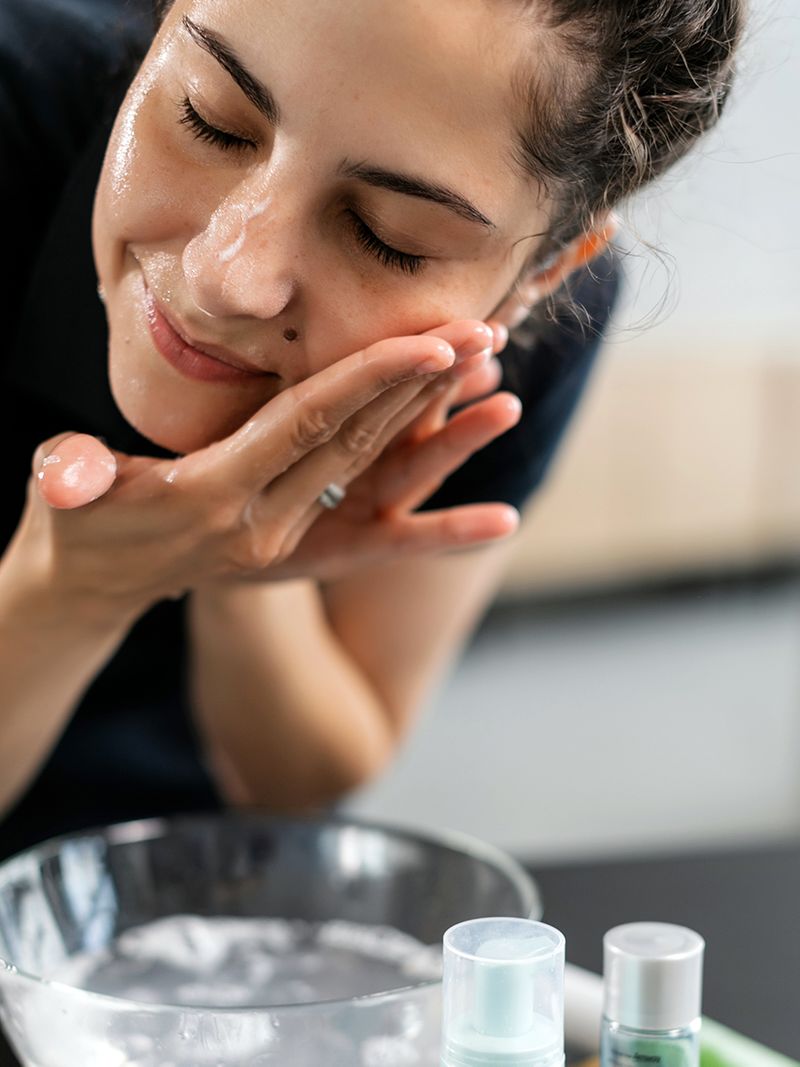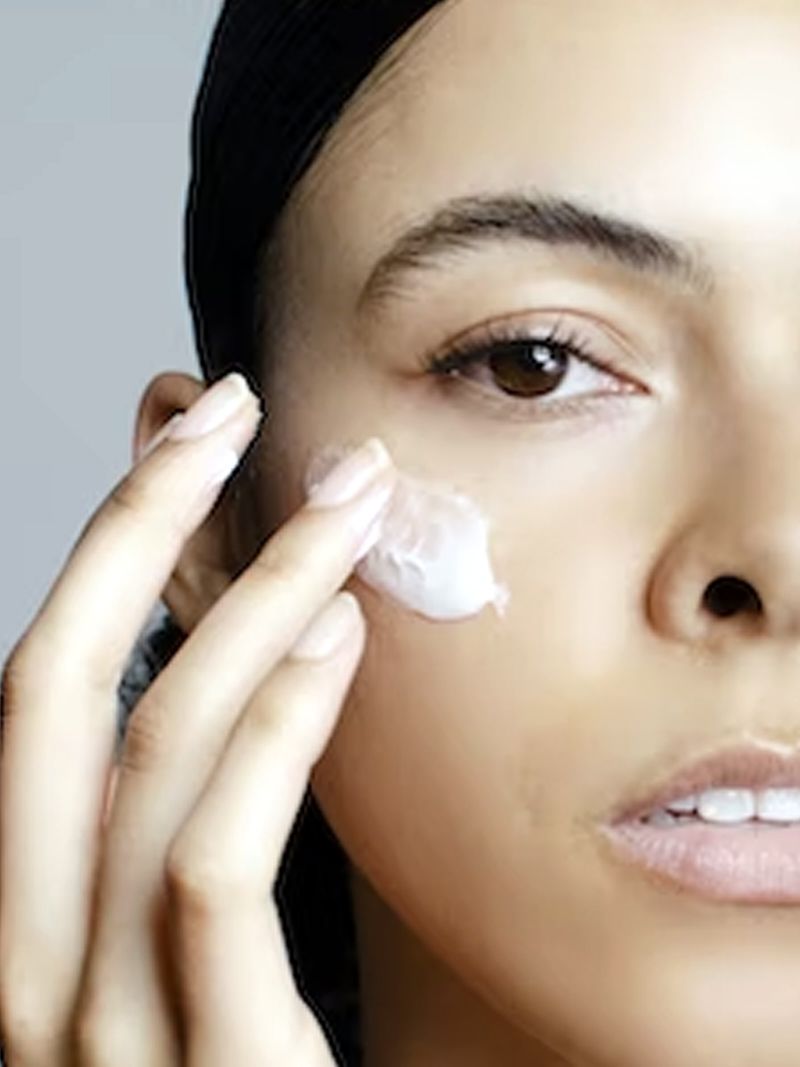
There are a slew of beauty trends flooding social media, notably Tik-Tok, lately, and the newest one to generate interest is, the moisture-sandwich trend from South Korea. With a name like that, it’s hard to not pay attention. The best thing about this skincare technique? It’s easy, and no-fuss.
Often, we wax eloquent about ‘locking’ in moisture into our skin - but here, we actually sandwich it in - the word isn’t just ornamental. It is a boon for those with dry skin as well as people preparing for cold winters.
For this skincare technique, you lather on your products while your skin is damp, so that the ingredients can absorb much more effectively. As Dr Hassan El Husseini, dermatologist at Dr Kayle Aesthetic Clinic, Dubai, breaks it down further, “The idea is that by putting lighter, more watery products on damp skin and then layering something thicker, that water gets trapped for longer, promoting hydration within the skin.”
What is the moisture sandwich skincare routine?

I have been following this skincare ritual for 3 months now, and I have to say that it leaves your skin extremely dewy, moisturised and radiant.
Therefore, here’s how it goes. Moisture sandwich is a method where you lay your skincare products in such a manner that hydration is locked in. The idea behind it is quite straightforward: Sandwich the creams and oils between layers of moisture, which will in turn trap water in the skin and reduce water loss, thereby boosting the skin’s moisture levels.
Charlotte Palermino, CEO and co-founder of US-based beauty brand Dieux Skin had explained the systematic routine on her Instagram page. As she explains, the routine traps water in the skin and reduces trans-epidermal water loss. Thus, the water is embedded in the deeper layers for much longer, resulting in healthier and more radiant skin.
The method and the benefits
1) First you tap water on your face.
2) Then, apply a serum, and follow up by using moisturiser (a thick-balm like texture is optimal); and then a face oil.
3) and then a face oil. Repeat the process with a hydrating lotion and then seal the moisture into your skin with a face-cream.
4) Palermino suggests that those with dry skin should apply Vaseline and leave it on your face overnight.
5) There’s a three-second rule to follow, which means that you don’t waste more than three seconds before applying the next product.
The moisture-sandwich skincare routine essentially works best for dry or dehydrated skin.
You can modify the technique slightly for your lips as well. Dampen your lips with water, apply moisturiser, and then apply a thick layer of balm. By doing so, the balm will prevent any loss of moisture and reduce further peeling. “By dampening your mouth, you’re giving the moisturiser more of an opportunity to penetrate. It gives humectants or water-loving ingredients (like glycerine) in the formula more to hold on to. And then using something truly "occlusive" (or an ingredient that reduces evaporation of water), you’re giving your mouth an opportunity to heal and soak up all that water," says Palermino in her video.
Spirithoula Koukoufikis, senior medical aesthetician at Skinfluencer London in the UK, recommends that the skin should be damp from the first cleanse prior to the application of active and hydrating products. “This will lock moisture into the skin and allow actives to be deeply absorbed and ensure optimum results,” she says.
Spirithoula Koukoufikis, senior medical aesthetician at Skinfluencer London in the UK, recommends that the skin should be damp from the first cleanse prior to the application of active and hydrating products. “This will lock moisture into the skin and allow actives to be deeply absorbed and ensure optimum results,” she says.
We all want that ‘smooth and glowing skin’. Explaining the technique further, Edwige Gandin, beautician at Pastels Salon Dubai says, “Applying products to damp skin can help to enhance penetration or absorption of the active ingredients, making sure they work to best effect. In fact, this technique focuses on trapping in all the water to keep your skin feeling supple and well-moisturised. It helps your skin barrier to lock in moisture for resulting in smooth, glowing skin that has a silky appearance.”
This routine is not just a fad and leaves the skin hydrated and plump, according to those who have tried it.
Personal account
Nadia Ayoub, a 48-year-old communications consultant from Dubai and ‘skincare junkie’ as she calls herself, explains. “I have been following this skincare ritual for 3 months now, and I have to say that it leaves your skin extremely dewy, moisturised and radiant.” There is no particular age group required for this routine, every age group can benefit.

Grandmothers made sure we apply oil on dampened skin to lock the moisturiser in better. The major difference between that and the Korean way is first adding water-based products and then locking them in with a thick layer of moisturiser.
This routine has been around for a while in different variations, as Saniksha Adnani, make-up artist and educator asserts. “Indian grandmothers made sure we apply oil on dampened skin to lock the moisturiser in better. The major difference between that and the Korean way is first adding water-based products and then locking them in with a thick layer of moisturiser,” she explains.
South Koreans, known for their prolific beauty routines, have always done this, asserts Mukta Purain, the founder of the beauty start-up Miss Palletable.
“It’s not a new technique, perhaps a new name. The only difference I would say is the introduction of the final layer being an occlusive balm such as Vaseline or Aquaphor. If you look at K-beauty skin routines, they start with a toner, essence, serum, ampoule, and moisturiser.”
For Purain, the routine is instructive as it helps her gauge the layer of products that she wants to apply. “If my skin is really thirsty, I will notice as I add the layers onto my skin, my skin will drink it up very quickly. But if it isn't thirsty it will reach a point where my skin starts feeling a bit heavy.”

Start with a toner or a mist. This helps dampen the skin allowing quicker product absorption. Followed by an essence, which tends to be filled with hyaluronic acid. This helps hydrate the skin and it's an essential when it comes down to Korean skincare routines.
Purain breaks down the routine further and explains why each step is crucial, “Start with a toner or a mist. This helps dampen the skin allowing quicker product absorption. Followed by an essence, which tends to be filled with hyaluronic acid. This helps hydrate the skin and it's an essential when it comes down to Korean skincare routines. The essence is then followed by a serum or ampoule. The key difference between a serum and an ampoule is the concentration of active ingredients.”
She adds that an ampoule is far more concentrated and with a skin sandwich one would need a serum or ampoule that emphasises on hydration. “The final layer for sandwiching is Vaseline or Aquaphor. Because these are occlusive, their role is to lock all the treatments you have already applied and the moisture you have already applied on to your skin be retained. It literally builds a wall on your skin and prevents any form of moisture being released off your skin.”

What you need to keep in mind
With any trending skincare routine - as glamorous as they all sound - it’s important to take several factors into account before trying it out on the skin.
In the rush to attain that stunning dewy look, people can overlook essential steps such as actually knowing whether such techniques would work on their skin surface or not. There are quite a few disclaimers involved with the moisture-sandwich routine. It might be simple for sure, but for starters, you mustn’t use excessive layers and must exercise caution about the ingredients that you are using and ensure that they don’t work against each other and render your whole routine as counter-productive. Worse, the wrong permutations and combinations can lead to redness, irritation and breakouts.
Those with oily skin need to follow a few rules. Dr Marwa El Badawy, a specialist dermatologist at Fakeeh University Hospital, Dubai, explains that it is first crucial to understand one’s skin type before they can try the skincare routine.

For dry skin, the use of heavy emollients and moisturisers applied on damp skin is required to improve skin texture and prevent trans-epidermal water loss, which causes itching or discomfort.
She says, “The skin may be dry, oily, combination or sensitive. For dry skin, the use of heavy emollients and moisturisers applied on damp skin is required to improve skin texture and prevent trans-epidermal water loss, which causes itching or discomfort and is an existing scientific technique for eczema patients.”
El Badawy goes on to elucidate that oily skin that is prone to acne eruption will not benefit from excess moisture and culminate in worsening of the skin condition. Moreover, sensitive skin might not be able to tolerate the numerous layers of moistures and can result in dermatitis. So, consult your dermatologist if your skin is extra sensitive.
Dermatologists and beauty experts unanimously agree that retinol, and exfoliating acids are not advisable at all for the moisture-sandwich routine. The technique is most effective with hydrating serums and moisturisers, rather than something aggressive like retinol, says Dr Hassan “It can cause irritation,” he adds. If you have a skin condition like rosacea, it’s best to talk to your dermatologist before proceeding with the technique.

What can people with oily skins do?
Nevertheless, the solution for those with oily skin is to use a lighter moisturiser. Gandin advises, “Those who have more oily skin, need to use lighter formulations, otherwise they may end up with too much moisture present, which will leave skin looking shiny.”
Hyaluronic acid is another strong option for older people with lines and wrinkles, as El Badaway suggests, though it is not advisable for younger acne prone skin. She also emphasises that brands and products should not be mixed and that one must consult their dermatologist before experimenting with such routines.

I suggest for dehydrated skin to apply a hyaluronic acid serum such as HA Intensifier from Skinceuticals on damp skin followed by a moisturiser such as The Cream by Augustinus Bader.
Sarah Battikha, Founder of dermatology clinic FRAME in Dubai, has some suggestions for which hyaluronic acid can be beneficial, “I suggest for dehydrated skin to apply a hyaluronic acid serum such as HA Intensifier from Skinceuticals on damp skin followed by a moisturiser such as The Cream by Augustinus Bader,” she adds that this cream is far more beneficial for dry and mature skins.
So if you want to give it a shot and get that healthy skin - go for it - but if you have sensitive or oily skin, do talk to your dermatologist before trying it out.












